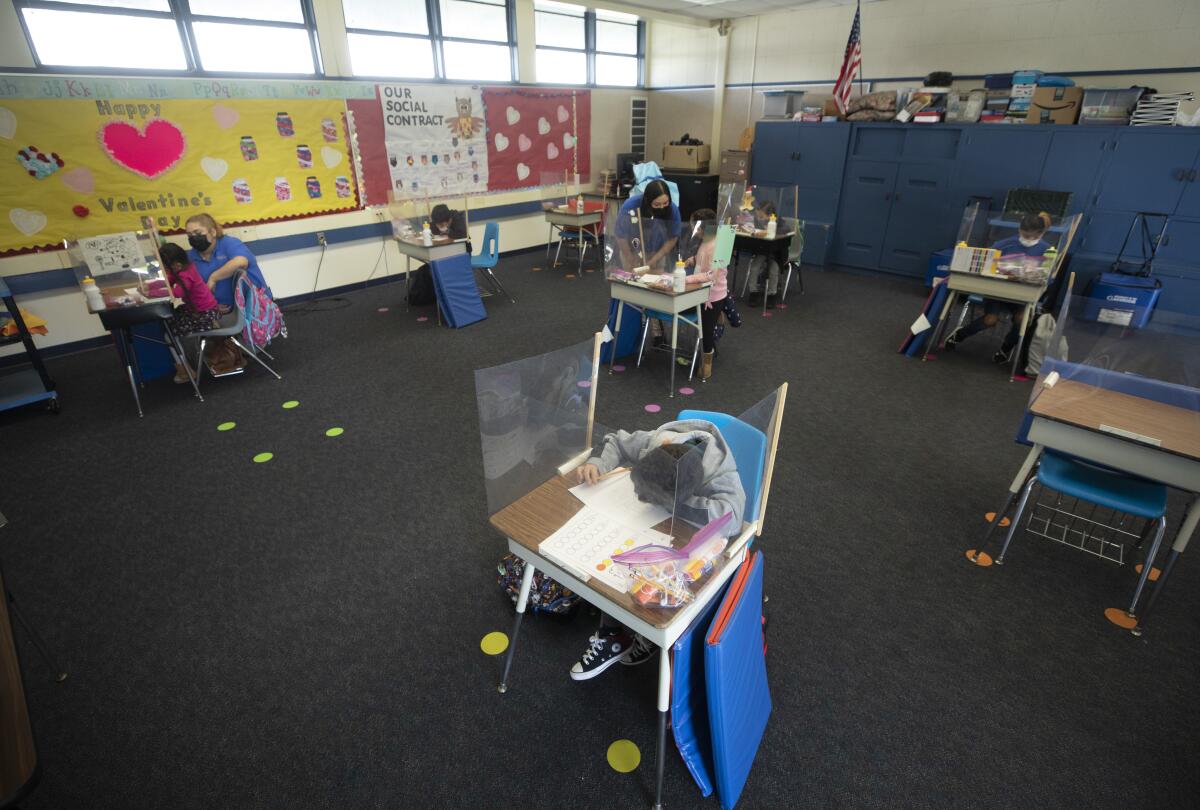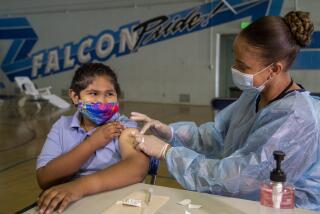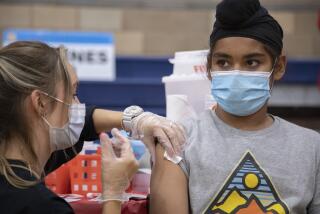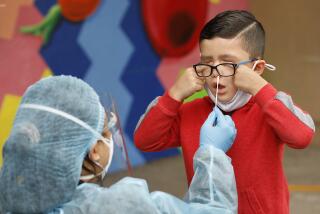Schools can safely move to reopen even if teachers are not all vaccinated, Newsom says

- Share via
Gov. Gavin Newsom said he believes schools can begin to reopen even if all teachers are not yet vaccinated against COVID-19, provided that proper safety measures and supports are in place — although some teachers unions, including United Teachers Los Angeles, have said vaccinations should be a prerequisite to resuming in-person instruction.
“We can safely reopen schools as we process a prioritization to our teachers of vaccinations,” Newsom said Wednesday.
“I’d love to have everybody in the state vaccinated that chooses to be vaccinated,” he said during a briefing held to announce the future opening of a community vaccination center at the Oakland Coliseum. “Not only would I like to prioritize teachers, we are prioritizing teachers.”
However, United Teachers Los Angeles and other teachers unions have balked at resuming in-person classes before teachers are inoculated. L.A. Unified Supt. Austin Beutner has said it is crucial that health officials specifically target school employees for vaccination while campuses are closed so that this impediment to reopening is removed.
“Vaccinating school staff will help get school classrooms opened sooner,” Beutner said this week.
Newsom’s comments came the same day that Dr. Rochelle Walensky, director of the U.S. Centers for Disease Control and Prevention, said schools can safely reopen even if all teachers are not vaccinated against COVID-19.
“I ... want to be clear that there is increasing data to suggest that schools can safely reopen, and that safe reopening does not suggest that teachers need to be vaccinated in order to reopen safely,” Walensky said at a briefing of the White House COVID-19 response team Wednesday. “Vaccination of teachers is not a prerequisite for safe reopening of schools.”
Jeff Zients, coordinator of President Biden’s COVID-19 task force, said Wednesday that the president wants schools to reopen and to stay open.
“And that means that every school has the equipment and the resources to open safely, not just private schools or schools in wealthy areas, but all schools,” Zients said.
When asked about the CDC director’s latest comments, Newsom said he subscribes “to the Biden administration’s point of view, reinforced again today in their press conference, that we can safely reopen schools with [an] appropriate level of support.”
“The science, reaffirmed by the Biden administration, is that schools can be safe learning and working environments with the right safety measures in place,” Daniel Lopez, Newsom’s press secretary, wrote in an email Wednesday afternoon. “The administration is focused on ensuring schools implement those science-grounded safety measures, incorporating vaccines as quickly as possible, but not waiting.”
A commentary by CDC researchers published in the Journal of the American Medical Assn. last month concluded that a path exists to “return primarily or fully to in-person instructional delivery,” but actions that need to be taken include “steps to reduce community transmission and limiting school-related activities such as indoor sports practice or competition that could increase transmission risk.”
There‘s little evidence that on-campus instruction has contributed meaningfully to increased community transmission, the researchers wrote. But there have been some notable exceptions.
In Israel, for instance, two infected students triggered a large outbreak within two weeks of their high school’s reopening in May. That outbreak was blamed in part on crowded classrooms and insufficient physical distancing. Also, because of hot weather, students were exempted from using face masks and air conditioners recycled interior air in closed rooms.
But overall, the CDC team wrote, most evidence “has been reassuring” because the kind of rapid spread seen in nursing homes and crowded workplaces has not been reported in schools. “Preventing transmission in school settings will require addressing and reducing levels of transmission in the surrounding communities through policies to interrupt transmission (e.g., restrictions on indoor dining at restaurants),” the researchers wrote.
A number of counties in California are finally seeing new daily coronavirus case rates fall to levels low enough to lead to school reopenings. Recently enacted state guidelines allow for elementary schools to reopen when the seven-day average of daily cases falls to 25 or fewer per 100,000 residents. For secondary schools, the adjusted rate is seven cases or fewer per 100,000 residents.
On Tuesday, Los Angeles County’s adjusted daily new case rate was 38.7 per 100,000, the state Department of Public Health reported. L.A. County Public Health Director Barbara Ferrer has suggested that it could be a matter of weeks before the threshold to allow districts to fully reopen elementary schools is reached.
Along with allowing healthcare workers, people living in nursing homes and other long-term care facilities, and seniors 65 and older access to the vaccine, local health officials also have the authority to allow teachers and other school staff to be vaccinated.
However, given the scarcity of shots and regional variances in the vaccine distribution pace, health officials in many counties have not allowed educators to be immunized, while other counties have opened to teachers.
For instance, the city of Long Beach, which runs its own public health department, has started vaccinating teachers, while the wider L.A. County Department of Public Health has not.
In the San Francisco Bay Area, some health agencies that had opened vaccine eligibility to those working in schools recently decided to stop and instead focus on healthcare providers, those living in long-term care facilities and seniors. Marin County announced on Jan. 21 that a limited supply of vaccine had forced health officials to prioritize doses for those at least 75 years old, and stopped scheduling appointments for categories of people in a lower-priority group, which includes teachers.
Newsom also emphasized that resources are a key piece to the school-reopening puzzle. In his proposed budget, released last month, the governor earmarked $4.6 billion to address learning loss, money that school districts are expected to use for an extended academic year or summer school. He called for $2 billion in reopening grants that would be available to every school district and campus-based charter school. His proposal has not been approved by Democratic lawmakers, who have strongly criticized it.
“I’m confident we can get to where we need to go, and that’s safely reopening our schools for in-person instruction — starting with the younger grades and those with special needs,” Newsom said. “I say this not academically or intellectually, but as someone with four young kids: The younger kids are not getting the benefits of distance learning that the older kids are. And I’m very concerned about the equity lens in terms of this conversation, because so many private schools are open.”
He continued, “I believe we can safely reopen public schools to in-person instruction with the appropriate levels of safety and support and accountability in terms of enforcing the rules of the road, and we are committed and resolved to doing that.”
More to Read
Sign up for Essential California
The most important California stories and recommendations in your inbox every morning.
You may occasionally receive promotional content from the Los Angeles Times.













